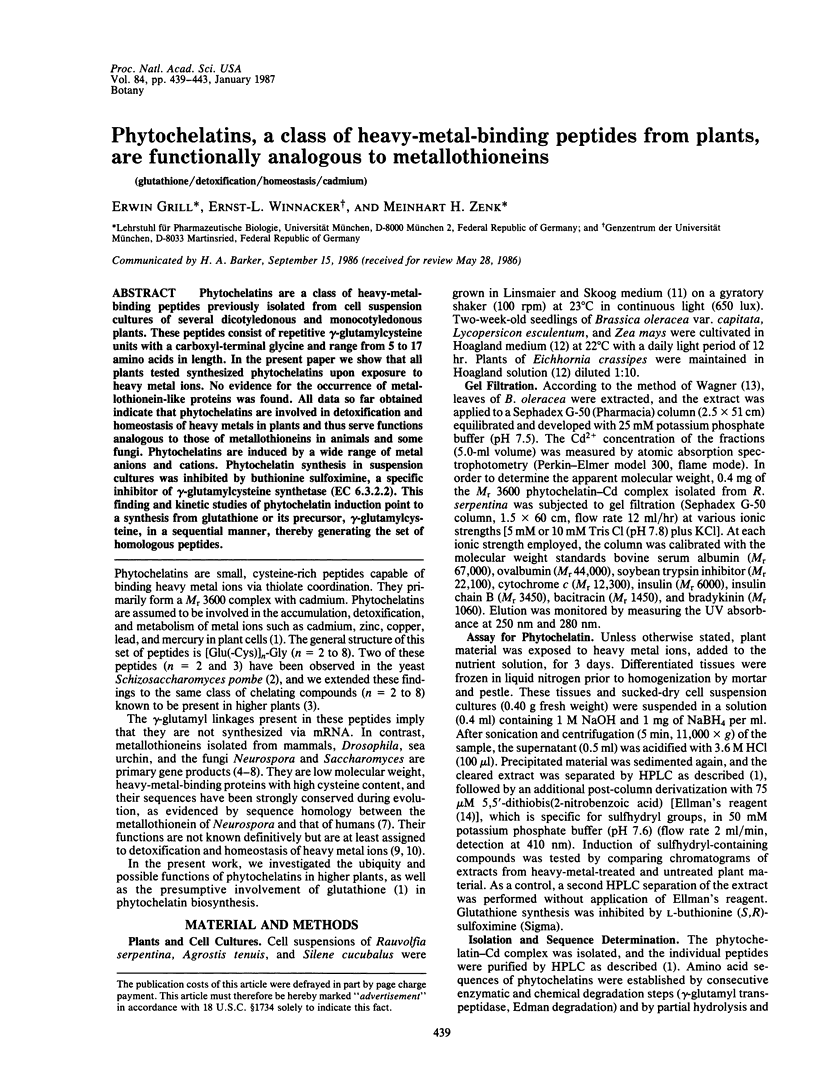Abstract
Phytochelatins are a class of heavy-metal-binding peptides previously isolated from cell suspension cultures of several dicotyledonous and monocotyledonous plants. These peptides consist of repetitive γ-glutamylcysteine units with a carboxyl-terminal glycine and range from 5 to 17 amino acids in length. In the present paper we show that all plants tested synthesized phytochelatins upon exposure to heavy metal ions. No evidence for the occurrence of metallothionein-like proteins was found. All data so far obtained indicate that phytochelatins are involved in detoxification and homeostasis of heavy metals in plants and thus serve functions analogous to those of metallothioneins in animals and some fungi. Phytochelatins are induced by a wide range of metal anions and cations. Phytochelatin synthesis in suspension cultures was inhibited by buthionine sulfoximine, a specific inhibitor of γ-glutamylcysteine synthetase (EC 6.3.2.2). This finding and kinetic studies of phytochelatin induction point to a synthesis from glutathione or its precursor, γ-glutamylcysteine, in a sequential manner, thereby generating the set of homologous peptides.
Keywords: glutathione, detoxification, homeostasis, cadmium
Full text
PDF




Selected References
These references are in PubMed. This may not be the complete list of references from this article.
- Bartolf M., Brennan E., Price C. A. Partial Characterization of a Cadmium-binding Protein from the Roots of Cadmium-treated Tomato. Plant Physiol. 1980 Sep;66(3):438–441. doi: 10.1104/pp.66.3.438. [DOI] [PMC free article] [PubMed] [Google Scholar]
- Butt T. R., Sternberg E. J., Gorman J. A., Clark P., Hamer D., Rosenberg M., Crooke S. T. Copper metallothionein of yeast, structure of the gene, and regulation of expression. Proc Natl Acad Sci U S A. 1984 Jun;81(11):3332–3336. doi: 10.1073/pnas.81.11.3332. [DOI] [PMC free article] [PubMed] [Google Scholar]
- Casterline J. L., Barnett N. M. Cadmium-binding components in soybean plants. Plant Physiol. 1982 May;69(5):1004–1007. doi: 10.1104/pp.69.5.1004. [DOI] [PMC free article] [PubMed] [Google Scholar]
- Cherian M. G., Vostal J. J. Biliary excretion of cadmium in rat. I. Dose-dependent biliary excretion and the form of cadmium in the bile. J Toxicol Environ Health. 1977 Mar;2(4):945–954. doi: 10.1080/15287397709529493. [DOI] [PubMed] [Google Scholar]
- ELLMAN G. L. Tissue sulfhydryl groups. Arch Biochem Biophys. 1959 May;82(1):70–77. doi: 10.1016/0003-9861(59)90090-6. [DOI] [PubMed] [Google Scholar]
- Glanville N., Durnam D. M., Palmiter R. D. Structure of mouse metallothionein-I gene and its mRNA. Nature. 1981 Jul 16;292(5820):267–269. doi: 10.1038/292267a0. [DOI] [PubMed] [Google Scholar]
- Griffith O. W., Meister A. Potent and specific inhibition of glutathione synthesis by buthionine sulfoximine (S-n-butyl homocysteine sulfoximine). J Biol Chem. 1979 Aug 25;254(16):7558–7560. [PubMed] [Google Scholar]
- Grill E., Winnacker E. L., Zenk M. H. Phytochelatins: the principal heavy-metal complexing peptides of higher plants. Science. 1985 Nov 8;230(4726):674–676. doi: 10.1126/science.230.4726.674. [DOI] [PubMed] [Google Scholar]
- Guy C. L., Niemi K. J., Brambl R. Altered gene expression during cold acclimation of spinach. Proc Natl Acad Sci U S A. 1985 Jun;82(11):3673–3677. doi: 10.1073/pnas.82.11.3673. [DOI] [PMC free article] [PubMed] [Google Scholar]
- Jackson P. J., Roth E. J., McClure P. R., Naranjo C. M. Selection, Isolation, and Characterization of Cadmium-Resistant Datura innoxia Suspension Cultures. Plant Physiol. 1984 Aug;75(4):914–918. doi: 10.1104/pp.75.4.914. [DOI] [PMC free article] [PubMed] [Google Scholar]
- Karin M. Metallothioneins: proteins in search of function. Cell. 1985 May;41(1):9–10. doi: 10.1016/0092-8674(85)90051-0. [DOI] [PubMed] [Google Scholar]
- Lastowski-Perry D., Otto E., Maroni G. Nucleotide sequence and expression of a Drosophila metallothionein. J Biol Chem. 1985 Feb 10;260(3):1527–1530. [PubMed] [Google Scholar]
- Lerch K. Copper metallothionein, a copper-binding protein from Neurospora crassa. Nature. 1980 Mar 27;284(5754):368–370. doi: 10.1038/284368a0. [DOI] [PubMed] [Google Scholar]
- Nemer M., Wilkinson D. G., Travaglini E. C., Sternberg E. J., Butt T. R. Sea urchin metallothionein sequence: key to an evolutionary diversity. Proc Natl Acad Sci U S A. 1985 Aug;82(15):4992–4994. doi: 10.1073/pnas.82.15.4992. [DOI] [PMC free article] [PubMed] [Google Scholar]
- Vallee B. L., Ulmer D. D. Biochemical effects of mercury, cadmium, and lead. Annu Rev Biochem. 1972;41(10):91–128. doi: 10.1146/annurev.bi.41.070172.000515. [DOI] [PubMed] [Google Scholar]
- Vasák M., Berger C., Kägi J. H. Dynamic structure of metallothionein. FEBS Lett. 1984 Mar 12;168(1):174–178. doi: 10.1016/0014-5793(84)80230-6. [DOI] [PubMed] [Google Scholar]
- Wagner G. J. Characterization of a cadmium-binding complex of cabbage leaves. Plant Physiol. 1984 Nov;76(3):797–805. doi: 10.1104/pp.76.3.797. [DOI] [PMC free article] [PubMed] [Google Scholar]
- Wagner G. J., Trotter M. M. Inducible cadmium binding complexes of cabbage and tobacco. Plant Physiol. 1982 Apr;69(4):804–809. doi: 10.1104/pp.69.4.804. [DOI] [PMC free article] [PubMed] [Google Scholar]


